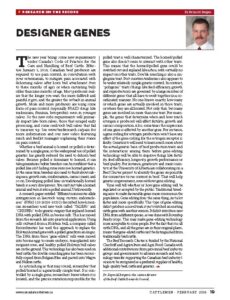Designer Genes
This article written by Dr. Reynold Bergen, BCRC Science Director, originally appeared in the February 2016 issue of Canadian Cattlemen magazine and is reprinted on the BCRC Blog with permission of the publisher.
The New Year brings some new requirements under Canada’s Code of Practice for the Care and Handling of Beef Cattle. Effective January 1, 2016, Canadian beef producers are required to use pain control, in consultation with your veterinarian, to mitigate pain associated with dehorning calves after horn bud attachment (2-3 months of age) or when castrating bulls older than nine months of age. Most producers realize that the longer you wait, the more difficult and painful it gets, and the greater the setback in animal growth. More and more producers are using some form of pain control (especially NSAID drugs like meloxicam, flunixin, ketoprofen) even in younger calves. So the new Code requirements will primarily impact late-born calves, those that escaped early processing, and some seedstock bull calves that fail to measure up. See www.beefresearch.ca/pain for more information and our new video featuring ranch and feedlot managers explaining their stance on pain control.
Whether a beef animal is horned or polled is determined by a single gene, so the widespread use of polled genetics has greatly reduced the need to dehorn beef calves. Because polled is dominant to horned, it can take generations before breeders can be confident that a polled line isn’t hiding some recessive horned genetics. At the same time, breeders also need to think about calving ease, growth rate, conformation, carcass merit, and so on. Developing polled lines in traditionally horned breeds is a very slow process. You can’t just take a horned animal and turn it into a polled animal. Until recently.
A research paper entitled “Efficient nonmeiotic allele introgression in livestock using custom endonucleases” (PNAS 110:16526-16531) described how American researchers used new tools called “TALENs” and “CRISPERs” to do genetic surgery that replaced horned DNA with polled DNA in bovine cells. This has moved from the research lab into practical application. Using cells cultured from a Holstein bull, a company called Recombinetics has used this approach to replace the Holstein horned gene with a polled gene from an Angus. The DNA from these “gene edited” cells were moved into bovine eggs to create embryos, transplanted into recipient cows, and healthy polled Holstein bull calves are on the ground. This technology has also been used on beef cattle; the double-muscling gene has been successfully copied from Belgian Blue and pasted into Wagyu and Nellore cattle.
As astonishing as that may sound, remember that polled/horned is a genetically simple trait. It is controlled by a single gene, researchers know where it is located, and the precise mutation responsible for the polled trait is well-characterized. The horned/polled gene also doesn’t seem to interact with other traits. This means that the horned/polled gene could be switched out and replaced like a fuse, with virtually no impact on other traits.
Double muscling is also a single gene trait. Post-mortem tenderness also appears to be under relatively simple genetic control.
In contrast, “polygenic” traits (things like feed efficiency, growth and reproduction) are governed by a large number of different genes that all have to work together in a coordinated manner. No one knows exactly how many or which genes are actually involved in those traits, or where they are all located. Not only that, but many genes are involved in more than one trait. For example, the genes that determine when and how much estrogen is produced will affect fertility, growth and carcass composition.
Also, sometimes the expression of one gene is affected by another gene. For instance, a gene coding for estrogen production won’t have any effect if the gene coding for the estrogen receptor is faulty.
Geneticists will need to learn much more about the actual genetic basis of beef production traits and the interactions among them before gene editing technology will be able to improve things like fertility, feed efficiency, longevity, growth performance or beef quality. For instance, geneticists and meat scientists at the University of Alberta are collaborating on a Beef Cluster project to identify the genes responsible for connective tissue content in beef. That will help genetic improvement, even without gene editing.
Time will tell whether or how gene editing will be regulated or accepted by the public. Traditional breeding aims to make favorable genes more common in the population. Gene editing does the same thing, just a lot faster and more specifically. This type of gene editing didn’t produce a novel trait; it just switched an existing cattle gene with another version. It didn’t introduce new DNA from a different species, as was done with Roundup Ready crops. This may make gene editing technology more acceptable to some people. But the fact that it is all cattle DNA, and all the genes are in their original places, means that gene-edited cattle can’t be distinguished from traditionally bred cattle.
Click here to subscribe to the BCRC Blog and receive email notifications when new content is posted.
The sharing or reprinting of BCRC Blog articles is typically welcome and encouraged, however this article requires permission of the original publisher.
We welcome your questions, comments and suggestions. Contact us directly or generate public discussion by posting your thoughts below.
